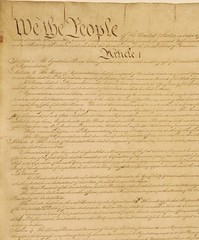Law is generally defined as a system of rules and regulations that are equal for everyone and are enforced through a set of institutions. The political system, economy and society are shaped by it in numerous ways and serves as a primary social mediator of relations between people. The US constitution is its supreme law and is the base of the legal authority for the existence of US and the federal government of the United States.
The history of law is very old and it began since the start of mankind even before the time when written laws and courts had ever existed. Ancient Greece, Egypt and in Babylonia of Mesopotamia region thousands of years back had their laws. The US started a movement for its constitution after getting independence from the British.
Customary laws dictated human actions for a long time by reflecting the conduct of people to each other. The natural law was discovered following the customary law. The United States Constitution is the shortest and oldest written constitution still in use by any nation in the world today.
The framework for the organization of the US government and for the relationship of the federal government to the states and its people was provided in the constitution. Although the Declaration of independence was a statement of principles but it did not form a government or a political framework to show how the governance would be done. The US had been practicing governance for a long time before the Declaration of Independence but the concept of sovereignty of people in the republic was new.
There were also commercial and trade laws that existed in the Middle Ages through which trade and transactions in Europe were governed. They were suitable for certain standards for normalizing the international trade. The constitution of the United States was the source for establishing a strong central or federal government with broad powers to regulate relations between the states and with sole responsibility in such areas as foreign affairs and defense.
The 20th century historians are of a view that legal history is a more contextualized mode that is more in line with the thoughts of social historians. The US constitution has three branches – executive judicial and. Legislative. In addition, it has two houses – upper house and lower house.
The case law and civil codes were achieved by analyzing different aspects of the case results. Different parameters like social science investigation, statistical methods, analyzing class differences, petitioners and players in varied legal processes were used by legal historians to evaluate the case histories.
You might want to learn the history of law and also the history of US Constitution
.
Article from articlesbase.com

New TYT Network channels: www.youtube.com www.youtube.com New TYT Facebook Page(!): www.facebook.com Follow us on Twitter: twitter.com www.theyoungturks.com DISCOUNTS: www.theyoungturks.com FREE Movies(!): www.netflix.com Note: The above two links are for TYT sponsors. Read Ana’s blog and subscribe at: www.examiner.com TYT Network (new WTF?! channel): www.youtube.com Check Out TYT Interviews www.youtube.com
Video Rating: 0 / 5
Related The Constitution Articles



